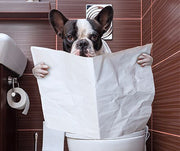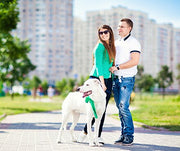Do Dinnertime Right

FEEDING YOUR DOG
Feeding dogs seems like it would be a simple thing to do, and for the most part, it is. Feeding a dog properly, however, is a bit more complicated. It involves so much more than just getting the proper dog feeding and watering supplies. What, when, and how to feed a dog are questions every owner must ask. This article will help you sort through all of the opinions and claims and help you keep your pup healthy and happy.
WHAT TO FEED YOUR DOG
Finding the right dog food can seem extremely confusing. Every food on the market claims it's nutritious and well-balanced. What does that mean for dogs, though? You want to read labels and make sure you're getting something good for your furry friend.
One thing to look for is a protein-rich food. Even if you may be a vegetarian, your dog needs protein from meat. Look for dog foods that list meat like chicken, lamb, and fish as their primary ingredient. This is especially true for puppies, who need plenty of the nutrients that meat-based protein provides.1
One of the hottest new trends in dog food (yes, there are hot new trends in dog food) is the raw or frozen food diet. This consists of serving your dog raw, whole meats to most closely resemble their natural, wild diet. The thought is that mimicking a dog's natural diet will offer a healthier lifestyle. Think of it as doggie paleo. Many dog food companies have embraced this craze and are offering frozen dog foods that are made from raw meats. A raw food diet for your dog does, however, have a few major drawbacks. You must keep the food frozen at all times until it is time to thaw and serve. You must also be cognizant of proper raw food handling to prevent bacteria and disease from forming. Lastly, this food can tend to be the most expensive option.2
Dry kibble is the type of dog food recommended most often. Canned and semi-moist dog food is often mostly water, up to 80 percent. That means you are essentially paying more for less nutrition. Plus, these types of foods spoil faster than dry food, so it is important to be aware that wet foods need to be picked up after some time. For puppies, you may mix some moist food with the dry food, but eventually, wean them off the moist stuff. Plus, you won't have to say "moist" anymore.
When you are choosing your dog food, avoid cheap, grain-based foods. These types of foods get most of their protein from grains, like corn and rice, and all protein is not made the same. Grain-based proteins don't have the nutrients your pup needs to grow up healthy. They may be cheaper, but when it comes to dog food, you get what you pay for. Cheap dog foods are kind of like junk food for humans. They may taste OK, but you can't live a long, healthy life eating it every day. Spending a little more on dog food will not only keep your dog healthier, but happier too. To keep your dog's food fresh, be sure to store it in a Vittles Vault Food Storage Container. These food storage containers have patented air-tight seals that lock moisture out and keep freshness in.
One last thing about what to feed your dog keep it consistent. Variety may be the spice of life, but for dogs, it is a recipe for digestion issues. Dogs do not mind eating the same thing every day. Switching your dog's food can upset his tummy, which could end up upsetting your carpet and you. If you still are unsure of which food is right for your furry little one, talk to your veterinarian.3
HOW MUCH TO FEED YOUR DOG
Once you have figured out what to feed your dog, you will need to determine how much to feed him. Now, if you ask most dogs, they will tell you to feed them all the food. That is why you should not ask your dog. To figure out how much to feed your canine requires considering several variables.
The size, weight, activity level and breed all factor into how much food your dog needs. The bigger and more active the dog, the more food he is going to require. Even the type of food will weigh into the amount of food your dog should get every day. Cheaper dog foods tend to not have as many nutrients, so you have to feed your dog more for him to get the nutrients he needs. While nutrient-rich foods may be more expensive, you do not have to feed your dog as much, so the costs are offset to a degree.
Every dog is different, so you will need to monitor his weight, energy level, and overall health.
Here is a dog-feeding chart4 for dry food to act as a starting point:
Less than 10 lbs. = 1/4 to 1/2 cup
10 to 20 lbs. = 1/2 to 1 cup
20 to 30 lbs. = 3/4 to 1 1/2 cups
30 to 40 lbs. = 1 1/2 to 2 cups
40 to 60 lbs. = 1 1/2 to 2 1/2 cups
60 to 80 lbs. = 2 1/2 to 3 cups
80 to 100 lbs. = 3 to 4 cups
100 to 150 lbs. = 4 to 5 cups
More than 150 lbs. = 4 1/2 to 6 cups
WHEN TO FEED YOUR DOG
Dogs should be fed twice a day. Once in the morning and once at night. It is also helpful to try and stick to the same time every day as much as possible. Again, dogs like routine, so keeping them on a feeding schedule is good for them.5 If your schedule differs from week to week or you have a hard time sticking to a schedule, consider purchasing an automated dog feeder like the Nano to keep your dog's feeding schedule on track. Automated dog feeders allow you to schedule the amount and time you'd like the food to dispense. This way, your pet stays fed and you can continue on with your busy schedule. Also, like everything else, this varies by size and breed, so check with your veterinarian.
DOGS WITH WEIGHT ISSUES
Some dogs have an insatiable appetite, and when owners indulge them too often, it can lead to those dogs becoming overweight. Click here to see if your dog's overweight. Now, getting a dog's weight under control takes a great deal of discipline on the owner's part.
You don't necessarily have to switch foods. Light dog foods have fewer nutrients, so you don't have to cut down on the amount you feed your portly pup as much. If you don't switch foods, you will need to cut back on the amount by 1/3 to 1/2. Your dog will not be thrilled with the decline in rations, but you can help ease the transition by adding a low-calorie filler. Green beans or canned pumpkin are great additions to your dog's food that will fill him up without filling him out. The key to getting your pup to shed the pounds is to be disciplined. He will be used to getting a lot of food and will whine a lot in the beginning. Be sure to keep his best interests at heart and be strong. Overfeeding is what got your dog in this predicament in the first place. Finally, adding in some exercise to your dog's daily life will be a great way to get your dog in great shape in no time.6
Dog dining is not as simple as it should be. There are many variables that go into figuring out what type of food is best, and how much to feed him. By doing your homework, being mindful of your dog's behavior and consulting with your vet, you can make sure that Fido is well fed, healthy and happy.
Sources:
- Roper, Kelly "Top 9 Healthiest Dog Foods – Love To Know" Web. 10 March 2015
- Szabo, Julia "Five Tips For Serving Your Frozen Dog Food" May 25, 2012
- Jean, Dr. "Top 10 Myths About Pet Food and Nutrition" Only Natural Pet. Web. 10 March 2015
- "Feeding an Adult Dog" DogTime. 27 April 2009. Web. 09 March 2015
- "Dog Feeding Schedules" Dogster. Web. 10 March 2015
- "Feeding an Overweight Dog" DogTime. Web. 10 March 2015
Previous article

Next article

Related posts
View all-

How to Keep Your Pet Calm During Thanksgiving
Thanksgiving is a time for family, friends, and food, but for our pets, the holiday can be overwhelming. The sudden change in routine, unfamiliar faces and scents, and increased noise can trigger significant stress. Understanding why your pet might feel anxious is the first step toward creating a peaceful holiday experience for everyone, including your furry family members. This guide offers calming tips for pets and practical solutions to ensure your dog or cat feels safe and secure during the festivities.
Read Article -

Top Travel Essentials for Pets This Holiday Season
Holiday travel often means bringing the whole family along, and for many of us, that includes our furry companions. Preparing for holiday pet travel is about more than just packing a bag; it's about ensuring your pet's safety, comfort, and happiness from the moment you leave home until you return. A little planning helps reduce stress for both you and your pet, making the journey a positive experience for everyone involved.
Read Article -

Best Leashes and Collars for Daily Walks: A Pet Parent’s Guide
A daily walk with your dog isn't just a chore—it's a chance to bond, explore, and stay active together. The right leash and collar can make every walk safer and more enjoyable for both of you. With numerous styles and materials available, it's essential to find gear that suits your dog's needs and your lifestyle.
Read Article



